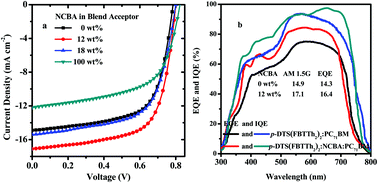Improved efficiency and thermal stability of ternary all-small-molecule organic solar cells by NCBA as a third component material†
Abstract
In this work, organic solar cells (OSCs) were fabricated with a blend of PC71BM and p-DTS-(FBTTh2)2 employed as a binary photoactive layer and with a dihydronaphthyl-based C60 bisadduct (NCBA) small-molecule acceptor used as a third component material. We demonstrate that the short-circuit current density (JSC), open-circuit voltage (VOC), fill factor (FF), power conversion efficiency (PCE), and thermal stability can all be enhanced simultaneously. In addition, the crystallinity can be finely optimized and the photon harvesting ability was enhanced for short-wavelength light by adjusting the NCBA doping ratio, leading to efficient exciton dissociation and charge-carrier transport. At the same time, the ternary photoactive layer, with a small amount of NCBA as a third component material, reduced monomolecular recombination and bimolecular recombination under open-circuit and short-circuit conditions, respectively. Such a ternary structure with NCBA as a third component material helped enhance the crystallinity and fix the surface morphology of the photoactive layer, thus reducing the decay ratio while increasing the thermal annealing treatment time. Consequently, the PCE reaches 9.1% for ternary OSCs with a 12 wt% NCBA doping ratio in a blended acceptor, with 87.2% of the initial PCE value maintained after 100 h of thermal annealing treatment at 90 °C, which is much higher than that obtained for the PCE of binary OSCs.



 Please wait while we load your content...
Please wait while we load your content...